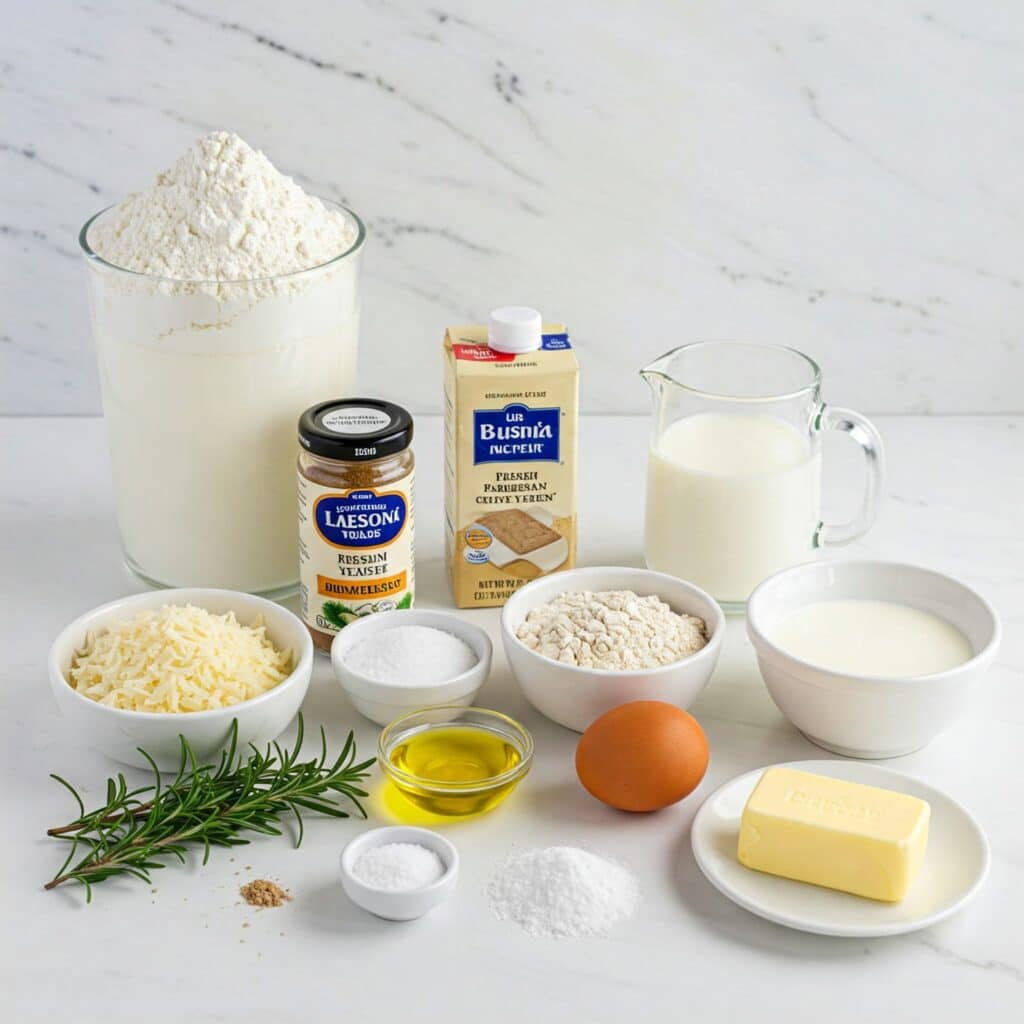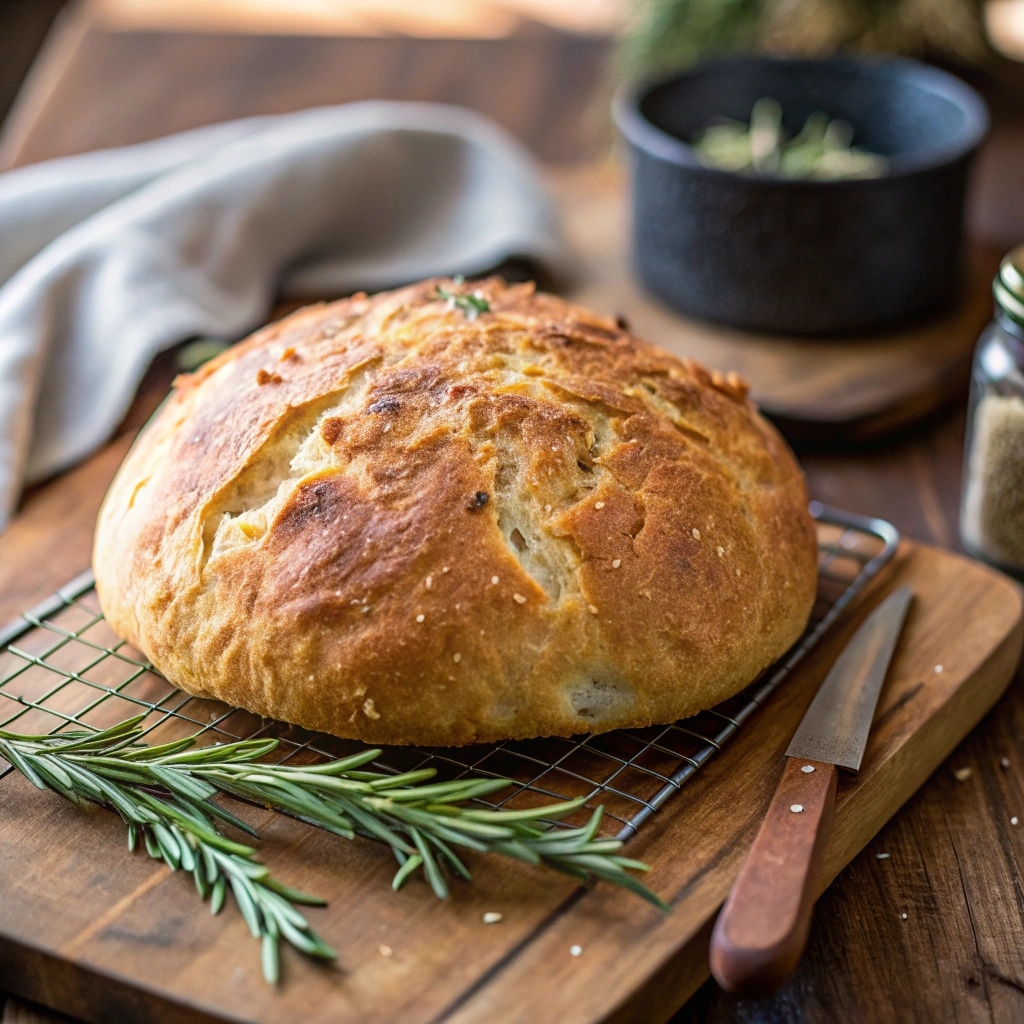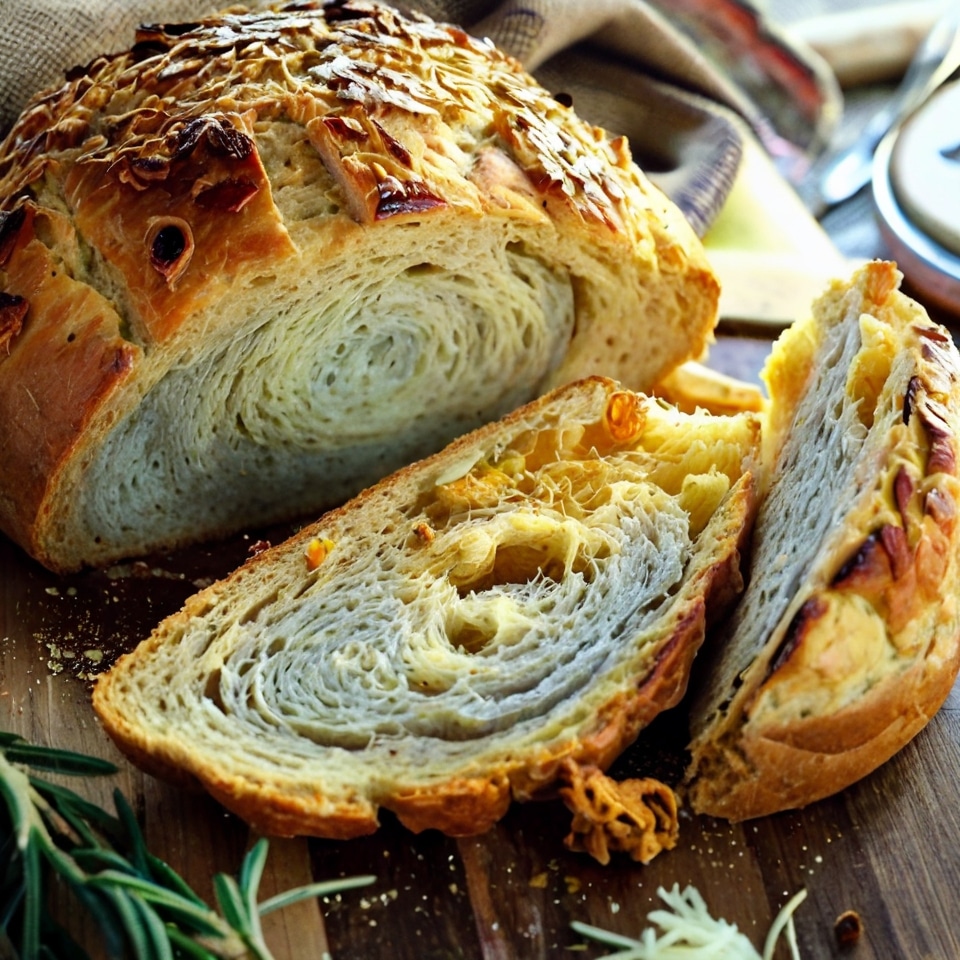Is there anything more comforting than the smell of freshly baked bread wafting through the kitchen? When you add fragrant rosemary and savory Parmesan to the mix, you get a loaf that’s nothing short of irresistible. Rosemary Parmesan Bread combines the perfect balance of herby freshness and cheesy goodness, making it a favorite for both everyday meals and special occasions.
In this article, we’ll guide you step by step on how to create this delicious bread at home. You’ll learn about the key ingredients, the baking process, and creative ways to serve it. Along the way, we’ll share tips to avoid common baking mistakes and answer frequently asked questions to ensure your loaf turns out perfect every time.
So, let’s get baking and discover how rosemary parmesan bread can become a staple in your kitchen!
What is Rosemary Parmesan Bread?
An Introduction to This Flavorful Bread
Rosemary Parmesan Bread is a classic yeast bread infused with fresh rosemary and topped with a generous layer of Parmesan cheese. This combination creates a loaf that’s soft, fluffy, and packed with savory flavor. The subtle aroma of rosemary pairs beautifully with the rich, nutty taste of Parmesan, making every bite a delight.
Unlike store-bought bread, homemade rosemary parmesan bread stands out with its artisan texture and natural flavors. Its crispy crust and soft, pillowy interior make it versatile enough to serve with everything from soups to pasta dishes.
Why Rosemary and Parmesan are the Perfect Pairing
The pairing of rosemary and Parmesan is a match made in culinary heaven. Rosemary, with its earthy and slightly piney flavor, adds a fragrant touch that’s both refreshing and aromatic. On the other hand, Parmesan brings a sharp, salty richness that balances the herbal notes perfectly. Together, these ingredients elevate a simple loaf into a gourmet experience.
Whether you’re a seasoned baker or a beginner, making rosemary parmesan bread is a rewarding way to impress your family and friends. It’s not just bread—it’s a flavorful masterpiece that complements almost any meal. Stay tuned as we dive into its origins, key ingredients, and the baking process that will have you reaching for seconds!
The Origins and Popularity of Rosemary Parmesan Bread
A Historical Look at Herb-Infused Breads
Herb-infused breads, like rosemary parmesan bread, have been enjoyed for centuries. In ancient times, bakers across the Mediterranean and Europe added herbs to bread not only for flavor but also for their aromatic properties and health benefits. Rosemary, in particular, was cherished by the Greeks and Romans for its earthy, pine-like aroma and believed healing qualities.
The tradition of combining herbs with bread grew over the years, and it became a staple in rustic kitchens. Rosemary added freshness, while olive oil and cheese enriched the flavor, transforming a simple loaf into a savory delicacy. It’s no wonder that rosemary parmesan bread has become so beloved in modern kitchens!
Why Rosemary Parmesan Bread Became a Household Favorite
So, why is rosemary parmesan bread such a hit today? For starters, it’s versatile. It works just as well with a cozy bowl of soup as it does as a centerpiece at a dinner party. Plus, the combination of rosemary and Parmesan offers a perfect blend of rustic and gourmet flavors.
This bread is also surprisingly easy to make. Even novice bakers can pull off a loaf with minimal effort. It doesn’t require fancy tools or complicated steps, making it ideal for home bakers.
Additionally, its artisan look makes it Instagram-worthy—something today’s food lovers truly appreciate. Whether you’re baking for yourself or hosting guests, rosemary parmesan bread always steals the show. It’s proof that a simple mix of ingredients can yield something extraordinary.
Making Delicious Rosemary Parmesan Bread
Key Ingredients for Rosemary Parmesan Bread
Making great Rosemary Parmesan Bread starts with top-notch ingredients. Here’s a breakdown:
- Flour: 2 cups bread flour (for a light, airy texture) or all-purpose flour (for a slightly denser result).
- Yeast: 1 packet (2 1/4 teaspoons) instant yeast (for fast rising) or active dry yeast.
- Milk: 1 cup warm milk (around 120°F) to enrich the dough and make it soft.
- Rosemary: 2 tablespoons fresh rosemary, minced (essential for that distinct flavor). If using dried rosemary, use only 1 tablespoon.
- Parmesan Cheese: 1/2 cup freshly grated Parmesan cheese (for rich, nutty flavor and a great crust).
- Olive Oil: 2 tablespoons olive oil (for moisture, flavor, and helping the Parmesan stick).
- Sugar: 1 tablespoon sugar (to feed the yeast).
- Salt: 1 teaspoon salt (to enhance the flavors).
- Egg: 1 large egg, beaten (for richness and binding).
- Butter: 2 tablespoons melted butter (for flavor and richness).

Fresh vs. Dried Rosemary – What Works Best?
When making Rosemary Parmesan Bread, the type of rosemary you use makes a big difference. First, fresh rosemary is the best choice. Its bright scent and strong taste really go into the bread, giving it a special herbal taste that dried rosemary just can’t match. Also, fresh rosemary adds nice green specks, which makes the Rosemary Parmesan Bread look good.
On the other hand, dried rosemary can be used if you have to, but it has a stronger taste. Therefore, if you use dried rosemary, use half as much as fresh rosemary, so the bread doesn’t taste too much like herbs. Even so, nothing beats the fresh, strong taste of real rosemary in Rosemary Parmesan Bread.
Choosing the Right Parmesan Cheese
Parmesan cheese is also very important in this recipe for Rosemary Parmesan Bread. To get the best Rosemary Parmesan Bread, use real Parmesan, not the pre-grated kind you find on shelves. Freshly grated Parmesan melts well and gives a nutty, savory taste that makes the Rosemary Parmesan Bread even better.
Furthermore, you can change the texture by using:
- Shredded Parmesan: This gives the Rosemary Parmesan Bread a cheesier bite and a golden crust.
- Grated Parmesan: This spreads the flavor evenly in the Rosemary Parmesan Bread dough.
Ultimately, whatever type you pick, good quality Parmesan matters. For the best flavor in your Rosemary Parmesan Bread, use real Parmesan.
Other Essential Ingredients: Flour, Yeast, Milk, and Olive Oil
Flour is key for Rosemary Parmesan Bread. Bread flour works best because it has more protein, which makes the bread soft and airy. However, if you only have all-purpose flour, that will work too, but the Rosemary Parmesan Bread might be a little heavier.
Next, instant yeast makes the bread-making faster and easier. Nonetheless, you can use active dry yeast if that’s what you have.
Additionally, warm milk makes the Rosemary Parmesan Bread dough richer, making a softer, fluffier inside. It also makes the bread taste better.
Finally, a bit of olive oil adds wetness and helps the Parmesan stick to the outside of the Rosemary Parmesan Bread. It also makes the bread a little richer.
These simple, good ingredients make Rosemary Parmesan Bread that’s soft, tasty, and really good. Ready to bake some Rosemary Parmesan Bread? Let’s start!
Step-by-Step Guide to Making Rosemary Parmesan Bread
Preparing the Dough
Making Rosemary Parmesan Bread is easier than you think. First, get all your things ready: bread flour, instant yeast, warm milk, fresh rosemary, Parmesan cheese, and things you usually have like salt, sugar, and olive oil.
- Mix the Dry Ingredients: First, in a big bowl or mixer, put in 2 cups of bread flour, yeast, sugar, salt, and the small pieces of fresh rosemary. Mix it well.
- Add Wet Ingredients: Next, warm the milk (to about 120°F) and mix it with melted butter and a whipped egg. Then, slowly add this to the dry mix while mixing to bring the dough together.
- Knead the Dough: After that, change to a dough hook or knead by hand for about 8–10 minutes. Also, add more flour if you need to until the dough is soft, a little sticky, and stretchy.
Shaping and Rising the Bread
Being patient is important to get light Rosemary Parmesan Bread.
- First Rise: First, put the dough in a greased bowl, cover it with a clean towel, and let it sit for about 1 hour or until it doubles in size.
- Shape the Dough: Then, punch the dough down and cut it into two equal parts. Next, roll each part into a long, flat shape (about 14×7 inches). After that, roll them up tightly into loaf shapes and squeeze the edges closed.
- Second Rise: Finally, put the loaves into greased pans or on a baking sheet with paper. Brush them with olive oil and sprinkle lots of Parmesan cheese on top. Cover them and let them sit for another 30–45 minutes.
Baking to Golden Perfection
Finally, let the Rosemary Parmesan Bread cool a bit before cutting it. You’ll love the crispy Parmesan outside with the soft, herb-tasting inside.
First, heat your oven to 350°F.
Then, bake the Rosemary Parmesan Bread loaves for 25–30 minutes or until the tops are golden brown and the bread sounds empty when you tap it.
For a very crispy outside, broil it for 1–2 minutes at the end.

For another comforting bread recipe, you might enjoy this Easy Spaghetti Casserole Recipe, which pairs wonderfully with fresh-baked bread.
Serving Suggestions for Rosemary Parmesan Bread
Best Pairings with This Bread
Rosemary parmesan bread is incredibly versatile, making it the perfect addition to many dishes. Here are a few ways to serve it:
- With Pasta Dishes: Serve slices of this bread alongside pasta favorites like spaghetti bolognese, fettuccine alfredo, or lasagna. The herbaceous rosemary and cheesy Parmesan complement rich sauces beautifully.
- Soups and Stews: Nothing beats dipping warm, crusty bread into a hearty bowl of butternut squash soup or beef stew. The flavors of the bread elevate simple soups to gourmet meals.
- Cheese Boards and Charcuterie: Use the bread as part of a charcuterie spread with cheeses, olives, cured meats, and dips. Its savory notes pair wonderfully with creamy Brie or sharp cheddar.
Transforming Leftovers into New Dishes
Don’t let any of your rosemary parmesan bread go to waste! Leftovers can be transformed into new, tasty creations:
- Toasted Garlic Bread: Brush slices with olive oil, sprinkle with garlic powder, and toast them for a crunchy side.
- Homemade Croutons: Cube the bread, toss it with olive oil and herbs, then bake until golden and crispy. Perfect for soups and salads.
- Savory Bread Pudding: Combine leftover bread with eggs, cheese, and vegetables for a unique and satisfying meal.
This bread’s versatility makes it a staple you’ll come back to time and time again. Whether paired with dinner or enjoyed as a snack, rosemary parmesan bread adds a flavorful touch to any meal.
Common Mistakes When Making Rosemary Parmesan Bread
Over-Proofing or Under-Proofing the Dough
One of the most common mistakes when baking rosemary parmesan bread is improper proofing. If you let the dough rise too long (over-proofing), it can collapse and lose its airy structure. On the flip side, under-proofing leaves the bread dense and heavy. To get it just right, let the dough rise until it doubles in size. This usually takes about 1 hour for the first rise and 30–45 minutes for the second.
A simple trick to test proofing? Press your finger gently into the dough. If it springs back slowly, it’s ready for baking. If it springs back immediately, it needs more time.
Using Dried Herbs Instead of Fresh
Another common pitfall is substituting fresh rosemary with dried. While dried rosemary works in a pinch, it lacks the vibrant aroma and flavor that fresh rosemary brings to rosemary parmesan bread. Fresh herbs not only add depth to the bread’s flavor but also enhance its presentation.
If dried rosemary is your only option, reduce the quantity by half to avoid overpowering the bread. However, whenever possible, stick with fresh—it’s worth it!
Not Properly Balancing the Cheese and Herb Flavors
Adding too much or too little Parmesan cheese can affect the overall taste. Sprinkle just enough cheese on top to create a golden, crispy crust without overwhelming the rosemary flavor. Balance is key to ensuring every bite of rosemary parmesan bread is perfectly seasoned.
FAQs – People Also Ask
Can I Use All-Purpose Flour Instead of Bread Flour?
Yes, you can use all-purpose flour if you don’t have bread flour on hand. However, bread flour has more protein, which gives rosemary parmesan bread a chewier texture and better structure.
How Should I Store Rosemary Parmesan Bread?
Store the bread in an airtight container or wrapped in plastic at room temperature for up to 4 days. To keep it fresh longer, freeze it. Simply slice the bread, wrap it well, and store it in a freezer bag for up to 3 months.
Can I Make This Bread Without a Mixer?
Absolutely! While a stand mixer speeds up kneading, you can knead the dough by hand for about 8–10 minutes. It’s a great arm workout and ensures a perfectly soft and elastic dough.
Is This Recipe Suitable for Dinner Rolls or Mini Loaves?
Yes, this recipe is versatile! Divide the dough into smaller portions to create dinner rolls or mini loaves. Adjust the baking time to around 20–25 minutes for smaller sizes.
Bake and Enjoy Your Own Rosemary Parmesan Bread Today!
Making Rosemary Parmesan Bread at home is easier than you think and delivers a flavor-packed, golden-crusted loaf that’s perfect for any occasion. Whether served with pasta, soups, or simply enjoyed on its own, this savory bread will quickly become a favorite in your kitchen.
Ready to try more homemade recipes? Check out this simple Homemade Garlic Bread, learn how to pair bread with Classic Tomato Soup, or explore tips for baking with Fresh Herbs.
With its herby aroma and cheesy goodness, Rosemary Parmesan Bread is a crowd-pleaser you’ll bake again and again. Give this recipe a try today—you’ll be amazed by how simple and delicious it is to create a bakery-quality loaf right at home!


4 thoughts on “Homemade Rosemary Parmesan Bread: An Irresistible Recipe”